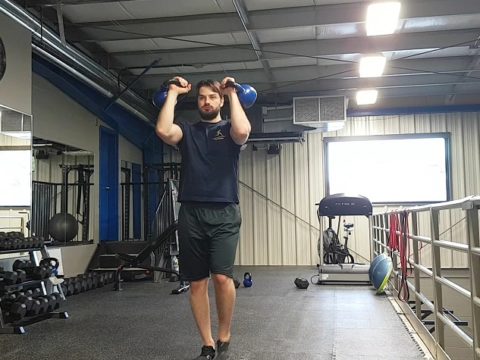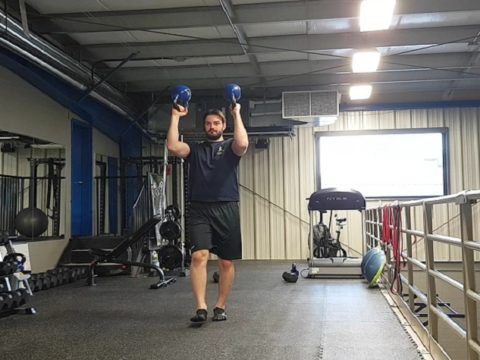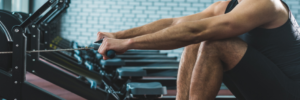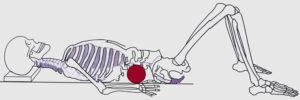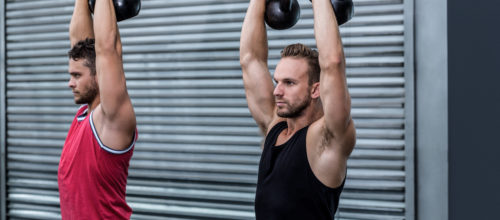
The Benefits of Programming Loaded Carries
Carries are one of my favourite exercises to program. And for many reasons:
Simple to coach.
Versatile.
Get’s people moving.
Challenges core stability; scapular stability; grip strength.
And everyone f*cking enjoys them.
What is a Carry?
A carry is an exercise that involves a person holding an object (e.g., dumbbell, kettlebell) in one or both hands and walking for a distance (e.g., 100 feet). The object can be at your side (farmer’s), kept close to the chest (racked), 90 degrees shoulder-elbow flexion, overhead (waiter’s), or offset (crosswalk). Each carry style (e.g., farmer’s, waiters) provides a unique challenge and benefit; which I will explain in detail below.
Farmer’s Carry:
Benefits: Grip Strength, Core Stability, Easy to Perform
Considerations: Out of all the carries – you will find people will be able to add the most load to a farmer’s carry. The farmer’s carry offers the greatest grip strength challenge out of all of the carries. Avoid pairing a farmer’s carry with an exercise that requires a high grip demand (e.g., deadlift, bench press). Also, a farmer’s carry contributes to scapular depression and may not be best for a population with low shoulders.

The picture on the left represents a farmer’s carry, and the picture on the right represents a single arm farmer’s carry. The single arm farmer’s carry adds a lateral core stability challenge (resist lateral flexion).
Racked Carry:
Benefits: Grip Strength, Core Stability, Easy to Perform, Spares the Shoulders
Considerations: Doesn’t offer significant core stability or scapular stability challenge. You will find people can use a lot of weight for a racked carry. Good alternative for someone with existing shoulder problems or has trouble getting overhead.
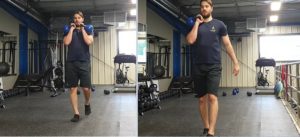
The picture on the left represents a racked carry, and the picture on the right represents a single arm racked carry. The single arm racked carry adds a lateral core stability challenge (resist lateral flexion).
90-Degree Shoulder-Elbow Flexion Carry:
Benefits: Grip Strength, Core Stability, Scapular Stability, Scapula Upward Rotation
Considerations: Offers significant core stability and scapular stability challenge. You will find people will not be able to use a lot of weight. People with existing wrist, elbow or shoulder issues need to be cautious. People with military posture (scapular adduction) may notice significant benefits from the scapular abduction and upward rotation.
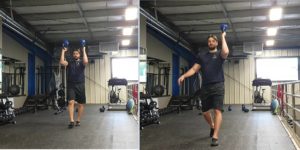
The picture on the left represents a bottoms-up 90-degree shoulder-elbow carry, and the picture on the right represents a bottoms-up single arm 90-degree shoulder-elbow carry. The single arm 90-degree shoulder-elbow carry adds a lateral core stability challenge (resist lateral flexion). The shoulder should be in a neutral position or slight abduction.
Waiter’s Carry:
Benefits: Grip Strength, Core Stability, Scapular Stability, Scapula Upward Rotation
Considerations: A waiter’s carry offers a greater anterior core stability challenge (center of gravity is higher) than a 90 degrees shoulder-elbow carry, but the scapular stability challenge is less. Similar to an 80-90 degree bottoms-up carry – you will find people will not be able to use a lot of weight. People with trouble getting overhead pain-free will struggle with a waiter’s carry.
Shoulder mobility limitations (e.g., short/stiff lat) may need work before progressing to a waiter’s carry. Great for a population that sits with low shoulders – since the overhead carry will help develop the scapula upward rotators (e.g., serratus anterior, lower trap, and upper trap).
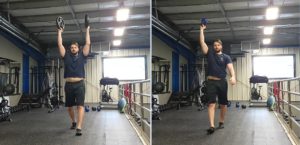
The picture on the left represents a waiter’s carry, and the picture on the right represents a single arm waiter’s carry. The single arm waiter’s carry adds a lateral core stability challenge (resist lateral flexion).
Crosswalk Carry:
Benefits: Grip Strength, Core Stability, Scapular Stability, Scapula Upward Rotation,
Considerations: A crosswalk carry is a variation that offers core stability and scapular stability benefits. The kettlebell overhead should be lighter than the kettlebell that is off to the side of the hip.
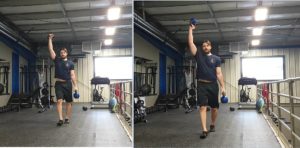
The picture on the left represents a crosswalk carry and the picture on the right represents a bottoms-up crosswalk carry. The bottoms-up crosswalk carry adds a grip strength challenge.
Grip Position – Neutral (Beginner):
Benefits: Easy to Perform, Core Stability, Scapular Stability
Considerations: A neutral grip carry will offer scapular stability and core stability challenges. Great for beginners or people with existing wrist, elbow or shoulder issues.
Grip Position – Bottoms Up (Advanced):
Benefits: Grip Strength and Scapular Stability
Considerations: A bottoms-up carry will offer a significant grip strength and scapular stability challenge. Beginner’s or people with existing wrist, elbow or shoulder problems need to be cautious with a bottoms-up progression.
Final Considerations for Programming Carries
I would avoid pairing carries with exercises that have a high rotator cuff or grip strength demand. Waiter’s carry, 90-degree elbow-shoulder flexion and bottoms-up grip carries have a high rotator cuff demand – pairing them with an exercise such as side lying external rotations would not be ideal. Also, carries have a high grip strength demand – which doesn’t make them good to pair with a deadlift or bench press.
I find carries tend to pair best with a core exercise, glute activation exercise, landmine press or hip mobility drill. But you can pair carries with many exercises; be sure to avoid pairing them with a rotator cuff or grip strength exercise. Also, carries can be a nice finisher to a workout. And if you’re running large group classes – carries can be easy to program – since they are simple to coach.
Salute,
Remi
“Thumbnail Image Licensed from “Wavebreakmedia/depositphotos.com.”

